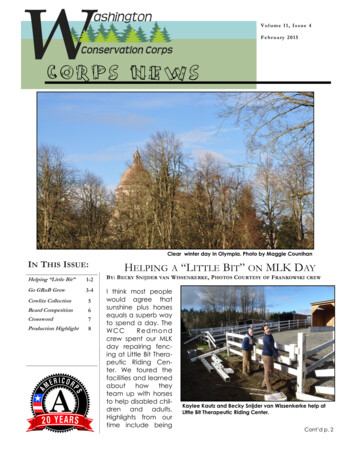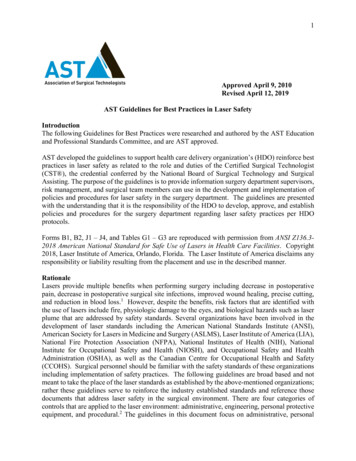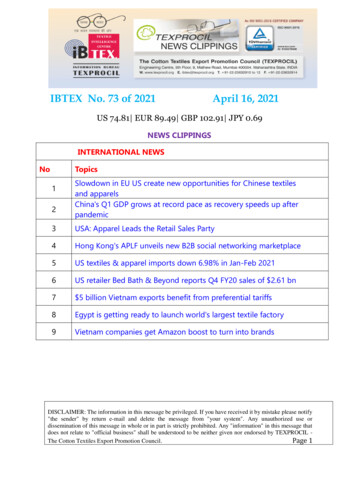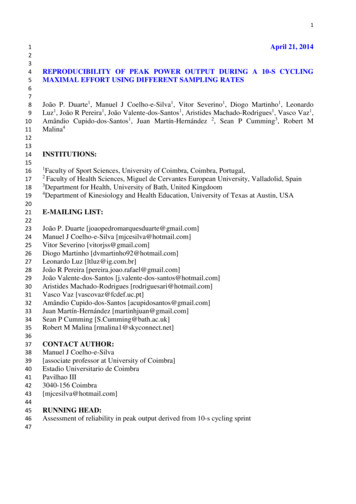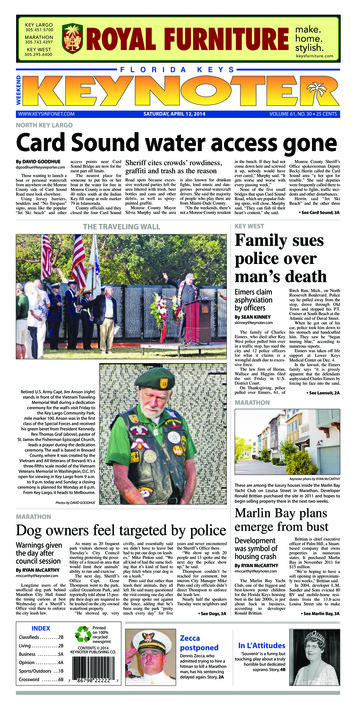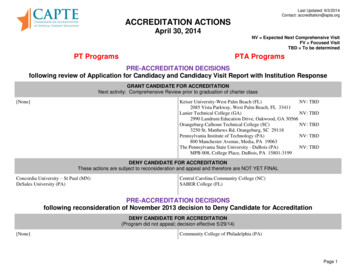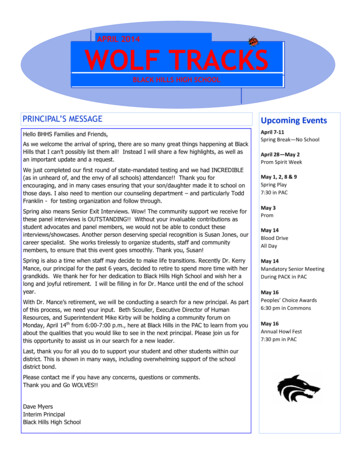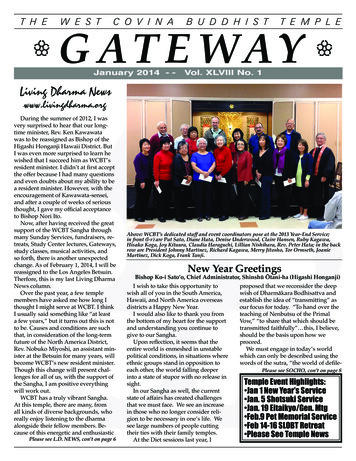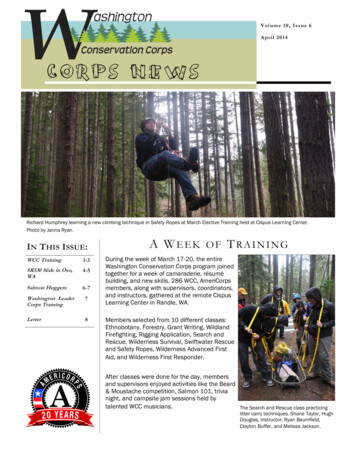
Transcription
V o l um e 1 0 , I s s ue 6A pr i l 2 0 1 4CORPS NEWSRichard Humphrey learning a new climbing technique in Safety Ropes at March Elective Training held at Cispus Learning Center.Photo by Janna Ryan.IN THIS ISSUE:WCC Training1-3SR530 Slide in Oso,WA4-5Salmon Huggers6-7Washington LeaderCorps Training7Letter8A WEEK OF TRAININGDuring the week of March 17-20, the entireWashington Conservation Corps program joinedtogether for a week of camaraderie, résumébuilding, and new skills. 286 WCC, AmeriCorpsmembers, along with supervisors, coordinators,and instructors, gathered at the remote CispusLearning Center in Randle, WA.Members selected from 10 different classes:Ethnobotany, Forestry, Grant Writing, WildlandFirefighting, Rigging Application, Search andRescue, Wilderness Survival, Swiftwater Rescueand Safety Ropes, Wilderness Advanced FirstAid, and Wilderness First Responder.After classes were done for the day, membersand supervisors enjoyed activities like the Beard& Moustache competition, Salmon 101, trivianight, and campsite jam sessions held bytalented WCC musicians.The Search and Rescue class practicinglitter carry techniques. Shane Taylor, HughDouglas, instructor, Ryan Baumfield,Clayton Buffer, and Melissa Jackson.
P age 2V o l um e 1 0 , I s s ue 6MARCH ELECTIVE TRAINING(Top) The Wilderness Survival class sets up athree-tiered system for water filtration. Manymembers of this class learned first hand howwarm (or not so warm) their personally builtshelters were. Cassandra Shirkey, HollyGroussman, Jake Smith, Gina Boland, BryanNoyes, Adam Thompson, and Julia Martel.(Bottom) Kirsten Miller treats her “patient,”Brooke Bannerman, in their Wilderness FirstResponder class.Photos courtesyof Janna Ryan.(Right) Forestry basics, in theaptly named, “Forestry Room.”Kirsten Boeson, Brett Wilson,Mikeal No-Line, Jennifer Fausey,Nick Jones, Andy Quast, DannySabo, Laura Schlabach, NancyToenyan, Mallory Peterson,Megan Brennan, GenevieveShank, and Adrian Ettinger.(Above) Ernie Farmer with a few of thecompetitors in the after hours “beard andmoustache” competition. Facial hair ranged fromfull beards to creepy moustaches as well asconvincing, yet artificial, beard hats and forestdwelling beards. Keep up the facial follicles WCC!Front row: Clark Paisley, Casey Branson, AbleWhitmore, Benjamin Kunesh, Sarah Wheatley,Katy Burmaster, Shea Scribner, Kate Terpstra.Back row: Justin Striker, Aaron Badillo, BrianFrankowski, Ryan Barker, and Ian Tate.
C OR P S N E W SP age 3The Grant WritingClass, making use ofthe library. RachelBrown, CliftonHermann, MelanieAnderson, and KiraJannusch workinghard on their writingskills.Dustin Morris isexcited to go homewith a hand-madecedar basket. TheEthnobotany classmade others jealousas they raved aboutpreparing a deliciousfeast of gathereddelicacies.“Great, fun,informational experience!”“Natural setting wasawesome.”“Overall fun week! Themusic at night wasawesome!”-Excerpts from trainingevaluations(Left) NatashaCoumou makingit look easy inSafety Ropes.(Right) BrentMcGinn singlehandedly pulls a9,000 lb truckusing amechanicaladvantagesystem set up bythe RiggingApplicationsclass.
P age 4V o l um e 1 0 , I s s ue 6S R 5 3 0 S L I D E I N O S O , WABy Kate Nagel, WCC Outreach Assistant and Garden Coordinator IPMy hometown, Arlington,WA, and the neighboringcommunities of Oso andDarrington have beendeeply affected by thetragic SR530 slide in Oso,WA that took place inMarch. Hearing PresidentObama and GovernorInslee speak about theseareas that I am so familiarwith gives me a wholenew perspective on themagnitude of thisdisaster.WCC’s AmeriCorps Members, Courtney Gilgore, D.J. Otis, Gina“The AmeriCorpsfamily holds thoseaffected by the tragedy inour thoughts and westand ready to assistwhere needed.”-Debbie Schuffenhauer,Executive Director,Serve WashingtonAccording to family andBoland, Morgan Gilchrist, and James Luttrell load their truck for Osofriends still living in thelandslide Response Deployment. Photo courtesy of Jay McMillen.area, the compassionateresponse has been remarkable. Local,Early on, Luke Wigle’s Port Angeles crewstate, and federal organizations, ashelped to establish the responder tentwell as community members fromcamp in Darrington. This required thenear and far have come together toconstruction of yurts that are now usedgive support in this time of need.for a variety of purposes like camplogistics, food services, laundry, wasteNine WCC AmeriCorps crews aredisposal, and sleeping quarters. Theassisting with the response to thecrew has continued maintaining camplandslide. They are providing logisticaloperations to support responders thatand ground support toresponders in thefield. Their effortshave included dataentry and orderingsupplies at thecommand post, campcoordination,processing inventory,donationmanagement,maintaining fuelservices, and shuttlingpersonnel andsupplies. Membershave also builtaccessibility rampsand helped toThe Port Angeles crew constructs a Yurt in Darrington at the respondermaintain generators.tent camp. Photo courtesy of Luke Wigle.
C OR P S N E W SP age 5are on the line.This set up issimilar to typicalwildfire camp crewduties.WCC forestry skillshave also been putto good use. Withthe interest ofinstalling LiDARequipment tomonitor thehillside above theErnie Farmer, crew supervisor, clears a path for LiDAR equipment to bedebris pile,installed above the debris field in Oso.engineers at theWashington Stateasked that WCC sawyers assist withDepartment of Transportation (WSDOT)clearing downed trees.This sophisticated mappingsoftware creates a 3Dimage that geologists cancompare to future maps ofthe site to determinewhether the hillside isshifting further and istherefore a risk to thesafety of responders below.Dallas Barron, Ernie Farmer, and Morgan Gilchrist assist withLiDAR installation. The yellow device in the background is part ofthe LiDAR equipment used to monitor shifts in the hillside aboverescuers.WCC crews will remain inArlington, Oso, andDarrington for severalmonths, as needed,completing 14 dayrotations.Although these crews arecompleting long shifts andhelping primarily withbehind the scenes tasks,they are working hard andstaying positive. A specialthanks to the localcommunity members forkeeping our crews goingwith home baked treatsand kind words.WCC member Gina Boland takes a shift at the IncidentCommand Post in Arlington.Photos courtesy of Jay McMillen.“All of this work [byWCC] occurs somewhatbehind the scenes, butthese tasks are essentialto the overall responseeffort.”-Maia Bellon,Washington Departmentof Ecology Director
P age 6V o l um e 1 0 , I s s ue 6SALMON HUGGERSBy Kris Staples-Weyrauch, Bellingham NSEA Crew MemberAs a returning WCC crew member, I knew this term would be a blast. The NSEAWhatcom County crew works exclusively in and around the Nooksack River and itstributaries in order to enhance salmon habitat. NSEA employees are amazing;everyone is productive, knowledgeable, and excited. Their attitude enhances ourcrew and we enjoy getting our hands dirty and feet wet working for the fish.With a crew full of second years we hit the ground running. We went to several sites,both private and public, spraying Himalayan Blackberry and Reed Canary Grass. Itwas my first time spraying, but I oddly enjoyed strapping a pack to my back andapplying herbicide. Brush-cutting is fun, but herbicide really works. Besides, I’m alsooutside, walking along the creek, waving a wand. What more could I ask for?As fall flew by and winter came, we shifted our focus from invasive plant removal tonative tree and shrub planting. It was rainy and cold, but our spirits were high as weplanted coniferous trees like Western Red Cedar and Douglas Fir, deciduous treessuch as Red Alder and Black Cottonwood, and shrubs for the understory includingSalmonberry and Pacific Ninebark. These native plants help to decrease erosionand provide the shade Salmonids need to survive their journey upstream.“I’m also outside,walking along the creek,waving a wand. Whatmore could I ask for?”Looking to the future, this spring will be awesome. NSEA will be starting theirSaturday volunteer work parties again in March, and with the sun’s return we willsee how our hard work pays off. Where once you saw a bramble of blackberry, youwill now see hundreds of trees well protected by blue tubes and caging. Everythingwe do here enhances the salmon, and thus our community, in some way.Continued on next page.Hannah Saldana, Brady Lester, Kris Staples-Weyrauch, Zach Shirk (supervisor), Jordan Mackey, andCourtney Born of the Bellingham NSEA crew.
C OR P S N E W SP age 7Through our work we have developed a special bond with the Salmon. Chinook,Coho, Chum, Pink, Sockeye, and Steelhead run through these waters and nourishthe soil with important minerals. Whenever we see one swim upstream we point itout and watch for a few seconds. In that moment our work is affirmed, and we feelfulfilled and satisfied. I never thought seeing a fish could bring me this muchexcitement and joy.WASHINGTON LEADER CORPSBy Ian Thompson, Thurston Spike Crew MemberWhen I first finished reading the agenda at the Washington Leader Corps (WLC)training, a few phrases stood out to me. “Nourishing the soul in service”, “Tai Chi”,and “meditation” were among those which almost made me laugh. I see myself as avery practical guy, and someone who just likes to “get the job done”. I used to thinkof these kind of practices as a silly waste of time, but I decided to go to this year’sWLC training nonetheless, and am so glad that I did!As I came to learn during the training, my headstrong“get er’ done” attitude is most like a “North” on thecompass wheel of personality types. Other typeswere Souths, who are all about the team and caringfor other people, Easts are amazing brainstormersand visionaries, and the Wests who love the detailwork, and can be great at logistics.The “compass wheel” is one of the most usefulleadership tools I have ever come across, and isalready helping me to interact more successfully withmy co-workers, and even with team members on my search and rescue unit. Now Ican more easily identify their strengths and their areas of challenge in order to getthe most out of everyone, and try to make sure that everyone is doing work that theyenjoy doing.Our instructor, Jeff Birdsall (who also teaches this course to WCC’s AssistantSupervisors at their training in January), was the perfect facilitator throughout thetraining. He was there just enough to get the conversations started, but he didn’trule the discussions. He had many great personal examples to share with us, but letus share and experience each others’ challenges and successes in leadership aswell.While I may still be skeptical of Tai Chi and meditation, I did take away a wealth ofknowledge and new experience with leadership which I believe will help meexponentially down the road and for the rest of my life.Tuesday, April 22nd is Earth Day!Send photos and stories from yourEarth Day festivities tokate.nagel@ecy.wa.gov!“The ‘compass wheel’ isone of the most usefulleadership tools I haveever come across.”
P age 8V o l um e 1 0 , I s s ue 6LETTER TO FISHER CREEK TEAM LORAXBy Sarah Wheatley, Urban Forestry Crew MemberLike us on rpsA group of youth were upset with the removal of their scotch broom forest. Theydelivered a letter detailing their concerns, yet still thanking the crew for their work.This is the letter in response, explaining the reasons for what the WCC crew wasdoing to their ‘forest.’Thank you for caring about Mother Nature! We think that’s awesome. We care aboutMother Nature too, and that’s actually why we’re doing this work! The plants we’retaking out are called invasive species, which means they are really good at takingALL the light and ALL the water and not letting anything else grow. They’re kind ofthe bullies of the plant world.If you need thispublication in analternate format, pleasecall 360-407-7248.Persons with hearing losscan call 711 forWashington RelayService. Persons with aspeech disability can call877-833-6341.Washington Departmentof EcologyPO Box 47600Olympia, WA 98504-7600www.ecy.wa.gov/wccApril 2014Volume 10, Issue 6Ecology Publication #14-06-015If you go to a healthy forest—maybe the park across the street, or RattlesnakeRidge, or Mount Si—you might notice there are lots of different kinds of plants.Different shapes, sizes and textures of leaves, berries and flowers, and all differentheights of plants. This is called biodiversity, and it means Mother Nature is healthy.When an invasive species takes over, it makes it really hard for other plants to grow,and you end up with just one or two kinds of plants instead of lots.If you just take out invasive species, and don’t plant anything in their place, guesswhat will come in MORE invasive species. So we’re going to plant more plants—avariety of native plants—in the coming weeks. Does that help? Would you like tohelp us plant new plants? Do you like salmonberries or thimbleberries? We wouldlove your help, if youwant to!Thank you again forcaring about MotherNature, and forSPEAKING UP! Keep upthe good work—MotherNature needs voices likeyours more than ever.And we are here to help.In friendship,The WCC Urban ForestryCrew: Ashley, Evan,Branden, Lindsey,Ashley Gould (supervisor), Austin Werts, Lindsey Juen, Branden Ellsworth,Austin, and SarahEvan Runquist, and Sarah Wheatley of the Urban Forestry Crew.A B O U T T H E WC CThe Washington Conservation Corps (WCC) was established in 1983 as a service programfor young adults between the ages of 18-25. The WCC is offered through the WashingtonDepartment of Ecology and continues the legacy started by the Civilian Conservation Corpsin the 1930s. The WCC has been an AmeriCorps program since 1994. Today, the WCC has278 members working on projects in every part of the state. Our partners include Federal,State, Local, and Tribal organizations. For more information please visit our website:www.ecy.wa.gov/wcc.
Service. Persons with a speech disability can call 877-833-6341. Volume 10, Issue 6 A group of youth were upset with the removal of their scotch broom forest. They delivered a letter detailing their concerns, yet still

